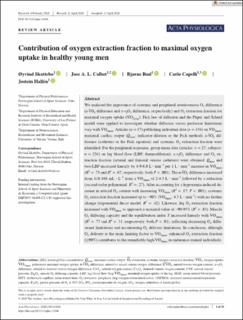| dc.contributor.author | Skattebo, Øyvind | |
| dc.contributor.author | Calbet, Jose Antonio Lopez | |
| dc.contributor.author | Rud, Bjarne | |
| dc.contributor.author | Capelli, Carlo | |
| dc.contributor.author | Hallén, Jostein | |
| dc.date.accessioned | 2021-02-10T09:00:26Z | |
| dc.date.available | 2021-02-10T09:00:26Z | |
| dc.date.created | 2020-10-30T10:24:06Z | |
| dc.date.issued | 2020 | |
| dc.identifier.citation | Acta Physiologica. 2020, 230(2), Artikkel e13486. | en_US |
| dc.identifier.issn | 1748-1708 | |
| dc.identifier.uri | https://hdl.handle.net/11250/2727072 | |
| dc.description | This is an open access article under the terms of the Creative Commons Attribution License (http://creativecommons.org/licenses/by/4.0/), which permits use, distribution and reproduction in any medium, provided the original work is properly cited. | en_US |
| dc.description.abstract | We analysed the importance of systemic and peripheral arteriovenous O2 difference (a-vO2 difference and a-vfO2 difference, respectively) and O2 extraction fraction for maximal oxygen uptake (VO2max). Fick law of diffusion and the Piiper and Scheid model were applied to investigate whether diffusion versus perfusion limitations vary with VO2max. Articles (n=17) publishing individual data (n=154) on VO2max, maximal cardiac output (Qmax; indicator-dilution or the Fick method), a-vO2 difference (catheters or the Fick equation) and systemic O2 extraction fraction were identified. For the peripheral responses, group-mean data (articles: n=27; subjects: n=234) on leg blood flow (LBF; thermodilution), a-vfO2 difference and O2 extraction fraction (arterial and femoral venous catheters) were obtained. Qmax and two-LBF increased linearly by 4.9-6.0 L · min–1 per 1 L · min–1 increase in VO2max (R2=.73 and R2=.67, respectively; both P<.001). The a-vO2 difference increased from 118-168mL · L–1 from a VO2max of 2-4.5 L · min–1 followed by a reduction (second-order polynomial: R2=.27). After accounting for a hypoxemia-induced de-crease in arterial O2 content with increasing VO2max (R2=.17; P<.001), systemic O2 extraction fraction increased up to ~90% (VO2max: 4.5 L · min–1) with no further change (exponential decay model: R2=.42). Likewise, leg O2 extraction fraction increased with VO2max to approach a maximal value of ~90-95% (R2=.83). Muscle O2 diffusing capacity and the equilibration index Y increased linearly with VO2max (R2=.77 and R2=.31, respectively; both P<.01), reflecting decreasing O2 diffusional limitations and accentuating O2 delivery limitations. In conclusion, although O2 delivery is the main limiting factor to VO2max, enhanced O2 extraction fraction (90%) contributes to the remarkably high VO2max in endurance-trained individuals. | en_US |
| dc.language.iso | eng | en_US |
| dc.subject | arteriovenous oxygen difference | en_US |
| dc.subject | cardiac output | en_US |
| dc.subject | exercise | en_US |
| dc.subject | leg blood flow | en_US |
| dc.subject | limiting factors | en_US |
| dc.subject | maximal oxygen uptake | en_US |
| dc.subject | oxygen diffusion | en_US |
| dc.subject | stroke volume | en_US |
| dc.title | Contribution of oxygen extraction fraction to maximal oxygen uptake in healthy young men | en_US |
| dc.type | Peer reviewed | en_US |
| dc.type | Journal article | en_US |
| dc.description.version | publishedVersion | en_US |
| dc.rights.holder | © 2020 The Authors. | en_US |
| dc.source.pagenumber | 19 | en_US |
| dc.source.volume | 230 | en_US |
| dc.source.journal | Acta Physiologica | en_US |
| dc.source.issue | 2 | en_US |
| dc.identifier.doi | 10.1111/apha.13486 | |
| dc.identifier.cristin | 1843524 | |
| dc.description.localcode | Institutt for fysisk prestasjonsevne / Department of Physical Performance | en_US |
| cristin.ispublished | true | |
| cristin.fulltext | original | |
| cristin.qualitycode | 1 | |
